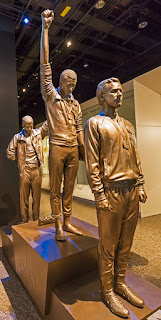A decade ago I used to go for business regularly to the “Swamp” (that may
be drained). I never cared about this
city since it was run down, dirty, with lots of street people and graffiti; but
it has cleaned its act and more appealing. I returned to see the new
Afro-American and Native American Museums.
This blog follows the walks to and from the hotel to the sites mentioned
above. Hotels are numerous in D.C. and, for contrast, the lobbies of the Henley Park
and the Marriott Marquis are below, the former from the late 1890’s and the latter
contemporary. I prefer the quaint old
one to the new one – with open space with a huge sculpture whose meaning is
only known to the creator.
Leaving the safety of the hotel’s lobby one encounters various monuments to personages of the past such as the one of Samuel Gompers (1850-1924) who founded the American Federation of Labor (AFL) to improve the working conditions of the working class. Ironically he opposed European and Chinese immigration because it lowered wages and were not easily assimilated…have things changed? And by the homeless making this monument a home, Samuel’s dream of achieving an American standard of living that provided adequate food, shelter and money still remains a dream.
Passing by the Capital Grill, a place where the politicians and lobbyists determine the future of the nation I crossed Constitution Avenue and entered the mall where a TV crew was getting ready to videotape an alternative news report. Notice the complex set-up of lighting and audio gear and signal transmitter all powered by small battery; not long ago this required a van and a larger crew; now two people can do it all with hand-carried equipment.
Arriving at the newly opened National Museum of African American History and Culture I found that I needed to have a pass to enter. But I was lucky; one of the attendants in the line had extra passes and I got in. Entering into the lobby I was greeted by a hanging of so called art work. I wondered what is this doing here and though this was misplaced and really belonged in the National Air and Space Museum since it resembles more a Klingon spacecraft.
The graphic arts were also represented by very colorful and attractive sculptures and paintings from artists that I never knew about but of great talent. There are lots of interactive exhibits and the various styles of music created by the Afro-American artist.
The building itself is an architectural mixture of styles that in my opinion was not well coordinated. The building exterior is basically of straight lines while internally is mostly curved in design. I found that the lay-out of the floors was difficult to follow since the exhibits were randomly located and hard to walk thru without missing some. This museum does not resemble in its layout the ones that I am accustomed to from the other museums in the Mall.
The National Museum of the American Indian is located at the other end of the Mall next to the Capital with a totally different architectural style. It was easier to navigate thru the exhibits than the museum previously visited and more in the style of the older Mall museums. Below there are two images of the main entrance to the museum in two renditions, both from the same image. The third image below is of the main lobby taken from the upper floor.
This museum describes the history of the native Americans from before the arrival of the Europeans to the present and emphasizes the number of treaties that were made with the U.S. Government. Most of these treaties were broken by the expansion of the western culture due to the search for gold and more lands across the continent. At the time there was a display of the Inca Road in South America. I did spent lots of time immersed in the exhibits and forgot to take more photos.
Leaving the American Indian Museum on my way back to the hotel I encountered a couple of chess players whose chessboard was stolen. I saw the Cuba Libre restaurant and decided to dine there. I pride myself of being a connoisseur of the famous “Cuban Sandwich” and decided to try one…well…close but not the real thing; for those you have to go to the Versailles or La Carreta restaurants in Miami. The restaurant bar area is supposed to be a copy of the famous “Floridita Bar” in Havana.
After dinner, I headed to my hotel and had to take a last photo of a striking facade of the Woodward and Lothrop Department Store opened in 1887 and known as Woodies that closed in 1995. The external facades are painted cast iron; this is the side fronting 7 Street NW that was clear of obstructions since the other sides allowed for parking obscuring the view. And for those interested, the photo taken handheld with a 11-24 mm lens at 18 mm, f 4 , 1/125 and ISO 8000; the wonders of digital photography.

































1 comment:
Oops! I sure have slipped up on this one!!
What a wonderful place to visit. There so much to see in Washington DC that I should have spent a couple of weeks there when I visited years ago instead of just 3 days.
I do agree about the 'Klingon' art.
The history of the American Indians is so sad. I have often wondered how the USA could dare to have its political stance towards SA when its past is littered with the same disgrace?
Post a Comment